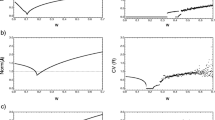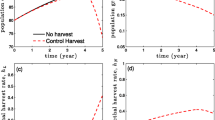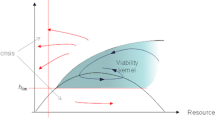Abstract
The World Summit on Sustainable Development (Johannesburg, 2002) encouraged the adoption of an ecosystem approach. In this perspective, we propose a theoretical management framework that deals jointly with three issues: (i) ecosystem dynamics, (ii) conflicting issues of production and preservation, and (iii) robustness with respect to dynamics uncertainties. We consider a discrete-time two-species dynamic model, where states are biomasses and where two controls act as harvesting efforts of each species. Uncertainties take the form of disturbances affecting each species growth factors and are assumed to take their values in a known given set. We define the robust viability kernel as the set of initial species biomasses such that at least one harvesting strategy guarantees minimal production and preservation levels for all times, whatever the uncertainties. We apply our approach to the anchovy-hake couple in the Peruvian upwelling ecosystem. We find that accounting for uncertainty sensibly shrinks the deterministic viability kernel (without uncertainties). We comment on the management implications of comparing robust viability kernels (with uncertainties) and the deterministic one (without uncertainties).





Similar content being viewed by others
Notes
This approach can be easily extended to more than two species in interaction.
Precisely, the biomass couple estimated in 1971 constitutes our starting state for simulating species biomasses. We plug this initial estimate of the anchovy–hake biomass couple and the 1971 catch values of each species in the deterministic version of the Lotka-Volterra model described in Eq. 11. This allows us to simulate the value of both biomasses in the following period. We renew this operation for each date until 1981, except that the current biomass couple we plug in the model the simulated one, while we apply the estimated catch couple of the current date all along.
References
Aubin, J.P. (1991). Viability Theory, (p. 542). Boston: Birkhäuser.
Béné C., & Doyen L. (2003). Sustainability of fisheries through marine reserves: a robust modeling analysis. Journal of Environmental Management, 69(1), 1–13.
Béné, C., Doyen, L., Gabay, D. (2001). A viability analysis for a bio-economic model. Ecological Economics, 36, 385–396.
Chapel, L., Deffuant, G., Martin, S., Mullon, C. (2008). Defining yield policies in a viability approach. Ecological Modelling, 212(1-2), 10–15.
Cury, P., Mullon, C., Garcia, S.M., Shannon, L.J. (2005). Viability theory for an ecosystem approach to fisheries. ICES Journal of Marine Science, 62(3), 577–584.
De Lara, M., & Doyen, L. (2008). Sustainable management of natural resources., Mathematical Models and Methods. Berlin: Springer.
De Lara, M., & Martinet, V. (2009). Multi-criteria dynamic decision under uncertainty A stochastic viability analysis and an application to sustainable fishery management. Mathematical Biosciences, 217(2), 118–124.
De Lara, M., Doyen L., Guilbaud, T., Rochet, M.J. (2007). Is a management framework based on spawning-stock biomass indicators sustainable? a viability approach. ICES Journal of Marine Science, 64(4), 761–767.
De Lara, M., Ocaña Anaya E., Ricardo Oliveros-Ramos, J.T. (2012). Ecosystem viable yields. Environmental Modeling & Assessment, 17(6), 565–575.
Doyen, L., & De Lara, M. (2010). Stochastic viability and dynamic programming. Systems and Control Letters, 59(10), 629–634.
Doyen, L., & Martinet, V. (2012). Maximin, viability and sustainability. Journal of Economic Dynamics and Control, 36(9), 1414–1430.
Doyen, L., De Lara, M., Ferraris, J., Pelletier, D. (2007). Sustainability of exploited marine ecosystems through protected areas: a viability model and a coral reef case study. Ecological Modelling, 208(2-4), 353–366.
Doyen, L., Thébaud, O., Béné, C., Martinet, V., Gourguet, S., Bertignac, M., Fifas, S., Blanchard, F. (2012). A stochastic viability approach to ecosystem-based fisheries management. Ecological Economics, 75(0), 32–42.
Eisenack, K., Sheffran, J., Kropp, J. (2006). The viability analysis of management frameworks for fisheries. Environmental Modeling and Assessment, 11(1), 69–79.
Garcia, S., Zerbi, A., Aliaume, C., Chi, T.D., Lasserre, G. (2003). The ecosystem approach to fisheries. Issues, terminology principles, institutional foundations, implementation and outlook. FAO Fisheries Technical Paper, 443(71).
Hilborn, R., & Walters, C.F. (1992). Quantitative fisheries stock assessment. Choice, dynamics and uncertainty. Chapman and Hall, New York, London, pp. 570.
IMARPE (2000). Trabajos expuestos en el taller internacional sobre la anchoveta peruana (TIAP), 9-12 Mayo 2000. Bol Inst Mar Peru, 19, 1–2.
IMARPE (2004). Report of the first session of the international panel of experts for assessment of Peruvian hake population. March 2003. Bol Inst Mar Peru, 21, 33–78.
Lauck, T., Clark, C.W., Mangel, M., Munro, G.R. (1998). Implementing the precautionary principle in fisheries management through marine reserves. Ecological Applications 81, Special Issue:72–78.
Martinet, V., & Doyen, L. (2007). Sustainable management of an exhaustible resource: a viable control approach. Resource and Energy Economics, 29(1), 19–37.
Martinet, V., Doyen, L., Thébaud, O. (2007). Defining viable recovery paths toward sustainable fisheries. Ecological Economics, 64(2), 411–422.
Martinet, V., Thébaud, O., Rapaport, A. (2010). Hare or Tortoise? Trade-offs in recovering sustainable bioeconomic systems. Environmental Modeling & Assessment, 15(6), 503–517.
Rawls, J. (1971). A theory of Justice. Oxford: Clarendon.
Sainsbury, K.J., Punt, A.E., Smith, A.D.M. (2000). Design of operational management strategies for achieving fishery ecosystem objectives. ICES Jounal of Marine Science, 57, 731–741.
Smith, S.J., Hunt, J.J., Rivard, D. (1993). Risk evaluation and biological reference points for Fisheries Management Canadian Special Publication of Fisheries and Aquatic Sciences No. 120. NRC Research Press, pp. 442.
Solow, R.M. (1974). Intergenerational equity and exhaustible resources. Review of Economic Studies 41:29–45, symposium on the Economics of Exhaustible Resources.
Acknowledgments
The authors thank Olivier Th?baud (IFREMER, France), Luc Doyen (CNRS, GREThA, University of Bordeaux 4, France), Vincent Martinet (INRA-?conomie publique, France), and Martin Quaas (Department of Economics, Christian-Albrechts-University of Kiel, Germany) for the helpful comments and suggestions.
Author information
Authors and Affiliations
Corresponding author
Appendices
Appendix A: The Deterministic Viability Kernel
The deterministic viability kernel, \(\mathbb {V}iab(t_{0})\), associated with the following dynamics (19) and constraints (20) and (21), for t = t 0,…,T, is the set of viable states defined as follows. A couple (y 0, z 0) of initial biomasses is said to be a viable state if there exist a trajectory of harvesting efforts (controls) (υ y (t),υ z (t))∈[0, 1], t = t 0,…,T−1, such that the state path \(\{\left (y(t),z(t)\right )\}_{t=t_{0},\ldots ,T},\) and control path \(\{\left (\upsilon _{y}(t),\upsilon _{z}(t)\right )\}_{t=t_{0},\ldots ,T-1}\), solution ofFootnote 3
starting from (y(t 0),z(t 0))=(y 0, z 0) satisfy the following goals:
-
Preservation (minimal biomass levels): for all t = t 0,…,T
$$ y(t) \geq y^{\flat} \; , \quad z(t) \geq z^{\flat} \; , and $$(20) -
Production requirements (minimal catch levels): for all t = t 0,…,T−1
$$\begin{array}{@{}rcl@{}} \upsilon_{y}(t) y(t) \mathcal{R}_{y}\left(y(t),z(t)\right)&\geq& Y^{\flat} \; ,\\ \quad \upsilon_{z}(t) z(t) \mathcal{R}_{z}\left(y(t),z(t)\right)&\geq& Z^{\flat} \; . \end{array} $$(21)
We now turn to the proof of Proposition 1 in Section 2.3.
Proof
Consider y ♭ ≥ 0, z ♭ ≥ 0, Y ♭ ≥ 0, Z ♭ ≥ 0. We set
and we define a sequence \((\mathbb {V}_{k})_{k\in \mathbb {N}}\) inductively by
For k = 0, we obtain
Then, for k = 1, we obtain
We now make use of the property (see [9]) that, when the decreasing sequence \((\mathbb {V}_{k})_{k \in \mathbb {N}}\) is stationary, its limit is the viability kernel \( \mathbb {V}iab(t_{0})\). Hence, it suffices to show that \(\mathbb {V}_{1}\subset \mathbb {V}_{2}\) to obtain that \( \mathbb {V}iab(t_{0}) = \mathbb {V}_{1}\).
Let \((y,z)\in \mathbb {V}_{1}\). We have that
Let us set \(\hat {\upsilon }_{y}= \frac {y\mathcal {R}_{y}(y,z)-y^{\flat }}{y\mathcal {R}_{y}(y,z)}\), which has the property that \(y{^{\prime }}=y\mathcal {R}_{y}(y,z)(1-\hat {\upsilon }_{y})= y^{\flat }\). We prove that \(\hat {\upsilon }_{y}\in [0, 1]\). Indeed, on the one hand, we have that \(\hat {\upsilon }_{y}\leq 1\) since \(1-\hat {\upsilon }_{y}=y^{\flat } / y\mathcal {R}_{y}(y,z)\), where y ♭ ≥ 0. On the other hand, since by assumption \(y\mathcal {R}_{y}(y,z)-y^{\flat }\geq Y^{\flat }\geq 0\), we deduce that \(\hat {\upsilon }_{y}\geq 0\). The same holds true for \(\hat {\upsilon }_{z}\) and \(z{^{\prime }}=z\mathcal {R}_{z}(y,z)(1-\hat {\upsilon }_{z})= z^{\flat }\). By Eq. 9, we deduce that
The inclusion \(\mathbb {V}_{1}\subset \mathbb {V}_{2}\) follows; hence, \( \mathbb {V}iab(t_{0}) = \mathbb {V}_{1}\), and (10) holds true. □
The viable controls attached to a given viable state (y, z)∈Vi a b(t 0) are the admissible controls (υ y , υ z ) such that the image by the dynamics (19) is in \(\mathbb {V}iab(t_{0})\).
Corollary 1
Suppose that the assumptions of Proposition 1 are satisfied. The set of viable controls associated with the state (y,z) is
where \(y{^{\prime }}= y\mathcal {R}_{y}(y,z)(1-\upsilon _{y}),\,\, z{^{\prime }}=z\mathcal {R}_{z}(y,z)(1-\upsilon _{z}) \).
Appendix B: Numerical Computation of Robust Viability Kernels
We first sketch how to establish a dynamic programming equation associated with dynamics (1), preservation (7), and production (8) minimal thresholds. Then, we depict a numerical discretization scheme to solve this equation numerically.
2.1 B.1 Dynamic Programming Equation
The dynamic programming equation associated with dynamics (1), preservation (7), and production (8) minimal thresholds is given byFootnote 4
for all t = t 0,…,T−1, where the continuous function G denotes the dynamics (1)
where \(\mathbb {A}\) stands for the subset of biomass satisfying conservation objectives (7)
and where \( \mathbb {B}(y,z,\varepsilon _{y},\varepsilon _{z})\) stands for the subset of catches satisfying minimal production requirements (8)
The notation \(1_{\mathbb {A}}(y,z)\) is the indicator function of the set \(\mathbb {A}\): it takes the value 1 when \((y,z)\in \mathbb {A}\) and 0 else. The same holds for \(1_{\mathbb {B}(y,z,\varepsilon _{y},\varepsilon _{z})}(\upsilon _{y},\upsilon _{z})\).
It turns out that, for all t = t 0,…,T, the robust viability value function V t is the indicator function \(1_{\mathbb {V}iab^{R}(t)}\) of the robust viability kernel \(\mathbb {V}iab^{R}(t)\) (see [6]). The sketch of the proof is as follows by backward induction.
By Eq. 22, we have that \(V_{T}=1_{\mathbb {A}}=1_{\mathbb {V}iab^{R}(T)} \). Now, assume that V t + 1 = \(1_{\mathbb {V}iab^{R}(t+1)}\). When the operation \(\min _{(\varepsilon _{y},\varepsilon _{z}) \in \mathbb {S}(t)}\) is performed in Eq. 22, the result is 1 if, and only if, for all uncertainties \((\varepsilon _{y},\varepsilon _{z}) \in \mathbb {S}(t)\), we have both \(1_{\mathbb {B}(y,z,\varepsilon _{y},\varepsilon _{z})} (\upsilon _{y},\upsilon _{z}) = 1 \) and \( 1_{\mathbb {V}iab^{R}(t)} \left (G(y,z,\upsilon _{y},\upsilon _{z},\varepsilon _{y},\varepsilon _{z}) \right ) = 1 \), that is, both efforts (υ y , υ z ) satisfy minimal production requirements (8) and the images G(y, z, υ y , υ z , ε y , ε z ) by the dynamics G belong to the viability kernel Vi a b R(t). Then, the operation \(\max _{(\upsilon _{y},\upsilon _{z}) \in [0, 1]^{2}}\) yields 1 if, and only if, there is at least one control (υ y , υ z )—indeed achieved by continuity of the dynamics G in Eq. 23—such that (8) is satisfied and G(y, z, υ y , υ z , ε y , ε z )∈Vi a b R(t). The term \(1_{\mathbb {A}}(y,z)=1\) if, and only if, the conservation objectives (7) are satisfied. To end, we obtain that V t (y, z) = 1 if, and only if, there exists at least one control (υ y , υ z ) such that the conservation objectives (7) and the production requirements (8) are satisfied, and that the images G(y, z, υ y , υ z , ε y , ε z ) by the dynamics G belong to the viability kernel Vi a b R(t) for all uncertainties \((\varepsilon _{y},\varepsilon _{z}) \in \mathbb {S}(t)\). By a simple extension of the results in [6] and [10], we have just characterized \(\mathbb {V}iab^{R}(t)\).
2.2 2.2 Numerical Resolution of the Dynamic Programming Equation
Now, we expose how we proceed to find the robust viability kernel numerically thanks to the dynamic programming (22).
We discretize biomass, harvesting effort, and uncertainty values. A top loop for time steps embraces two nested loops for state variables y and z respectively. Next, loops over uncertainties nested in loops over harvesting efforts allow us to obtain the set of images associated with a biomass couple (some of these steps are actually done through matrix computing). Images for target constraints that are not satisfied are set equal to zero. We then project these images on the value function grid of the previous period through linear interpolation. At given efforts, we retain the minimum value obtained over all uncertainty couples. Then, we retain the highest value produced by an effort couple among all tested. It is this value that is multiplied with the value function of the current time period at the location of the biomass couple at stake. The robust viability kernel is defined as the set of grid points where the value function is equal to 1. This implies that biomass couples for which, at a date t, all images do not fall between four 1 in the interpolation are excluded from the robust viability kernel (in the sense that we provide robustness with respect to grid approximation).
Rights and permissions
About this article
Cite this article
Regnier, E., De Lara, M. Robust Viable Analysis of a Harvested Ecosystem Model. Environ Model Assess 20, 687–698 (2015). https://doi.org/10.1007/s10666-015-9447-5
Received:
Accepted:
Published:
Issue Date:
DOI: https://doi.org/10.1007/s10666-015-9447-5




